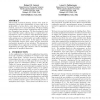Free Online Productivity Tools
i2Speak
i2Symbol
i2OCR
iTex2Img
iWeb2Print
iWeb2Shot
i2Type
iPdf2Split
iPdf2Merge
i2Bopomofo
i2Arabic
i2Style
i2Image
i2PDF
iLatex2Rtf
Sci2ools
AGENTS
2000
Springer
2000
Springer
The user interface as an agent environment
Theoretically motivated planning systems often make assumptions about their environments, in areas such as the predictability of action e ects, static behavior of the environment, and access to state information. We nd a striking correspondence between these assumptions and the properties of graphical user interfaces. We have developed a novel type of interface agent, called an ibot, to exploit these correspondences. Ibots can interact with o -the-shelf applications through the user interface rather than programmatically, gaining access to functionality not readily available to arti cial agents by other means. In this paper we describe the relationship between these agents and the theoretical and heuristic properties of user interfaces. We demonstrate the feasibility of our approach to interface agents with an implemented prototype that interacts with an unmodi ed application for graphical illustration.
| Added | 01 Aug 2010 |
| Updated | 01 Aug 2010 |
| Type | Conference |
| Year | 2000 |
| Where | AGENTS |
| Authors | Robert St. Amant, Luke S. Zettlemoyer |
Comments (0)

